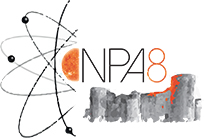Speaker
Dr
Nicolas de Séréville
(IPN Orsay)
Description
%
% Nuclear Physics in Astrophysics 8 template for abstract
%
% Format: LaTeX2e.
%
% Rename this file to name.tex, where `name' is the family name
% of the first author, and edit it to produce your abstract.
%
\documentstyle[11pt]{article}
%
% PAGE LAYOUT:
%
\textheight=9.9in
\textwidth=6.3in
\voffset -0.85in
\hoffset -0.35in
\topmargin 0.305in
\oddsidemargin +0.35in
\evensidemargin -0.35in
%\renewcommand{\rmdefault}{ptm} % to use Times font
\long\def\TITLE#1{{\Large{\bf#1}}}\long\def\AUTHORS#1{ #1\\[3mm]}
\long\def\AFFILIATION#1#2{$^{#1}\,$ #2\\}
\begin{document}
{\small \it Nuclear Physics in Astrophysics 8, NPA8: 18-23 June 2017, Catania, Italy}
\vspace{12pt}
\thispagestyle{empty}
\begin{center}
%%%
%%% Title goes here.
%%%
\TITLE{Understanding the origin of ``nova'' grains and the $^{13}$N($\alpha$,p)$^{16}$O reaction}\\[3mm]
%%%
%%% Authors and affiliations are next. The presenter should be
%%% underlined as shown below.
%%%
\AUTHORS{\underline{N.~de~S\'er\'eville}$^1$, A.~Meyer$^1$, F.~Hammache$^1$, A.~M.~Laird$^2$, M.~Pignatari$^3$ }
%%%
{\small \it
\AFFILIATION{1}{Institut de Physique Nucl\'eaire, CNRS-IN2P3/Universit\'e Paris-Sud, 91406 Orsay, France}
\AFFILIATION{2}{Department of Physics, University of York, York YO10 5DD, United Kingdom}
\AFFILIATION{3}{E.A. Milne Center for Astrophysics, Department of Physics \& Mathematics, University of Hull, HU6 7RX, UK}
}
%%%
\vspace{12pt} % Do not modify
% Enter contact e-mail address here.
\centerline{Contact email: {\it deserevi@ipno.in2p3.fr}}
\vspace{18pt} % Do not modify
\end{center}
%%%
%%% Abstract proper starts here.
%%%
Primitive meteorites hold several types of dust grains that condensed
in stellar winds or ejecta of stellar explosions. These grains carry
isotopic anomalies which are used as a signature of the stellar
environment in which they formed. As such,
extreme excesses of $^{13}$C and $^{15}$N in rare presolar SiC grains
have been considered as a diagnostic of an origin in classical novae,
however an origin in core collapse supernovae (ccSNe) has also been
recently proposed~[1].
In the context of ccSNe, explosive He shell burning can reproduce the
high $^{13}$C and $^{15}$N abundances if H was ingested into the He shell
and not fully destroyed before the explosion~[2]. The supernova shock
will then produce an isotopic pattern similar to the hot-CNO cycle
signature obtained in classical novae. Indeed in absence of H ingestion
there is no production of $^{13}$N in the helium region.
It has been shown that a variation
of a factor of five for the $^{13}$N($\alpha$,p)$^{16}$O reaction rate
induces several orders of magnitude in the production of $^{13}$N which
$\beta^+$-decays to $^{13}$C.
So far the $^{13}$N($\alpha$,p)$^{16}$O reaction rate is calculated
using a statistical model or the time reverse reaction and these
determinations have large uncertainties. We have determined an
experimental based reaction rate using the spectroscopic information
of the $^{17}$F compound nucleus. Alpha spectroscopic factors of the
states of interest ($E_x = 6.5 - 7.2$~MeV) in $^{17}$F were deduced
from those of the $^{17}$O mirror nucleus which were determined using
the $^{13}$C($^{7}$Li,t)$^{17}$O alpha-transfer reaction.
After a brief presentation of the astrophysical context of $^{13}$C and
$^{15}$N nucleosynthesis, the current situation of the
$^{13}$N($\alpha$,p)$^{16}$O reaction rate will be discussed. The
determination of spectroscopic information from the
$^{13}$C($^{7}$Li,t)$^{17}$O reaction will be presented together with
an R-matrix calculation of the $^{13}$N($\alpha$,p)$^{16}$O astrophysical
S-factor. The impact of the new reaction rate wil be discussed.
\bigskip
{\small
\noindent [1] N.~Liu et al. The Astrophysical Journal, 820:140 (2016).
\noindent [2] M.~Pignatari et al. The Astrophysical Journal Letters, 808:L43 (2015).
\noindent [3] A.~M.~Laird and M.~Pignatari, private communication.}
%%%
%%% End of abstract.
%%%
\end{document}
Author
Dr
Nicolas de Séréville
(IPN Orsay)
Co-authors
Ms
Alison Laird
(University of York)
Mrs
Anne Meyer
(IPN Orsay)
Ms
Fairouz Hammache
(IPN Orsay)
Dr
Marco Pignatari
(University of Hull)

